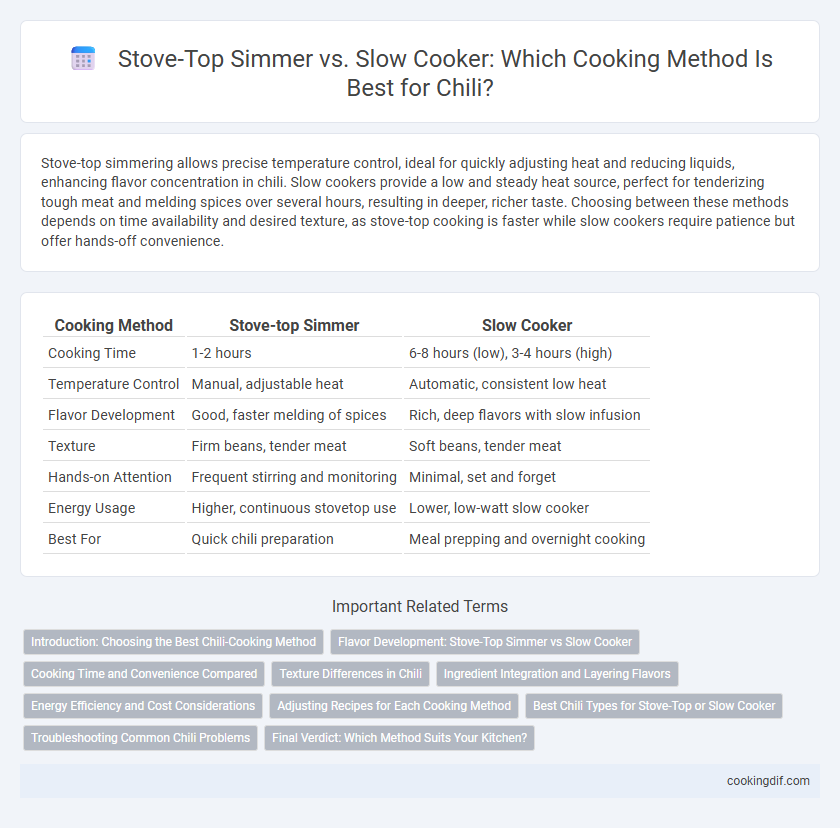Stove-top simmering allows precise temperature control, ideal for quickly adjusting heat and reducing liquids, enhancing flavor concentration in chili. Slow cookers provide a low and steady heat source, perfect for tenderizing tough meat and melding spices over several hours, resulting in deeper, richer taste. Choosing between these methods depends on time availability and desired texture, as stove-top cooking is faster while slow cookers require patience but offer hands-off convenience.
Table of Comparison
| Cooking Method | Stove-top Simmer | Slow Cooker |
|---|---|---|
| Cooking Time | 1-2 hours | 6-8 hours (low), 3-4 hours (high) |
| Temperature Control | Manual, adjustable heat | Automatic, consistent low heat |
| Flavor Development | Good, faster melding of spices | Rich, deep flavors with slow infusion |
| Texture | Firm beans, tender meat | Soft beans, tender meat |
| Hands-on Attention | Frequent stirring and monitoring | Minimal, set and forget |
| Energy Usage | Higher, continuous stovetop use | Lower, low-watt slow cooker |
| Best For | Quick chili preparation | Meal prepping and overnight cooking |
Introduction: Choosing the Best Chili-Cooking Method
Stove-top simmering allows precise temperature control and is ideal for achieving a rich, thick chili by reducing liquids gradually over low heat. Slow cookers offer convenience and consistent low-temperature cooking, enhancing flavor development by allowing spices and ingredients to meld over several hours. Selecting between these methods depends on time availability and the desired depth of flavor and texture in the chili.
Flavor Development: Stove-Top Simmer vs Slow Cooker
Stove-top simmering allows for more precise temperature control, enhancing the Maillard reaction and intensifying chili's rich, layered flavors through gradual reduction and caramelization. Slow cookers promote deep flavor integration by cooking chili at low, consistent heat over several hours, which tenderizes meat and melds spices thoroughly. While stove-top simmering may develop more complex, concentrated flavors faster, slow cookers excel at creating evenly blended, hearty chili with minimal risk of burning.
Cooking Time and Convenience Compared
Stove-top simmering chili typically takes 1 to 2 hours, allowing for quicker meal preparation but requires constant monitoring and occasional stirring to avoid burning. Slow cookers offer a hands-off approach, cooking chili evenly over 6 to 8 hours, which enhances flavor development and tenderizes ingredients without active supervision. Choosing between these methods depends on balancing available time and convenience, with slow cookers ideal for busy schedules and stove-top simmering suited for faster results.
Texture Differences in Chili
Stove-top simmering gives chili a more robust texture with varied bite from tender meat chunks and softened vegetables, as the direct heat allows precise control over consistency. Slow cookers produce a uniformly tender chili where ingredients meld into a rich, cohesive blend, ideal for softer textures. The choice between methods directly affects chili's mouthfeel, with stove-top offering textural contrast and slow cookers delivering a smooth, hearty stew.
Ingredient Integration and Layering Flavors
Stove-top simmering enables precise temperature control, promoting gradual integration of spices and herbs for complex chili flavors. Slow cookers enhance ingredient melding by cooking over extended periods at low heat, allowing flavors to fully develop and harmonize. The choice between methods impacts the depth of flavor layering, with slow cooking often yielding richer, more concentrated chili profiles.
Energy Efficiency and Cost Considerations
Stove-top simmering chili typically consumes more energy due to continuous use of gas or electricity, while slow cookers operate at lower wattage over extended periods, resulting in cost savings. Slow cookers maintain a consistent low temperature, reducing heat loss and offering higher energy efficiency, especially for recipes requiring several hours of cooking. Choosing a slow cooker can lower utility bills compared to stove-top methods, making it a budget-friendly option for slow-cooked chili dishes.
Adjusting Recipes for Each Cooking Method
Adjusting chili recipes for stove-top simmering involves monitoring heat to maintain a low, consistent temperature and stirring frequently to prevent burning, ensuring flavors meld correctly. In contrast, slow cooker recipes require reducing liquid amounts due to less evaporation and extending cooking times to allow spices and ingredients to develop deeper profiles gradually. Both methods benefit from starting with sauteed aromatics and browning meat to enhance the chili's overall richness and complexity.
Best Chili Types for Stove-Top or Slow Cooker
Thick, hearty chili with beans and ground beef benefits from slow cooker methods, allowing flavors to meld over hours and tenderizing tougher cuts like chuck roast. Stove-top simmer suits simpler chili recipes, such as quick bean chili or tomato-based chilis, where shorter cooking time preserves bright, fresh flavors and firmer textures. For spicier Tex-Mex style chili or those with delicate vegetables, stove-top simmering retains vibrant spices and prevents overcooking.
Troubleshooting Common Chili Problems
Stove-top simmering allows precise temperature control to prevent burning and overcooking chili, while slow cookers offer consistent low heat but risk uneven texture if cooked too long. Common chili problems like toughness from overcooked meat are less likely with slow cookers set properly, whereas stove-top methods require frequent stirring and monitoring to avoid sticking. Adjusting liquid levels is easier on the stove, making it ideal for managing chili thickness and flavor concentration.
Final Verdict: Which Method Suits Your Kitchen?
Stove-top simmering offers precise temperature control ideal for quick adjustments and achieving a robust chili flavor in less time, while slow cookers provide convenient, hands-off cooking with consistent low heat, allowing flavors to meld over several hours. Kitchens with limited counter space or busy schedules may benefit more from slow cookers, whereas those prioritizing texture and customization might prefer stove-top methods. Consider your time availability, desired flavor depth, and kitchen setup to determine the best chili cooking method for your needs.
Stove-top simmer vs slow cooker for cooking method Infographic

 cookingdif.com
cookingdif.com